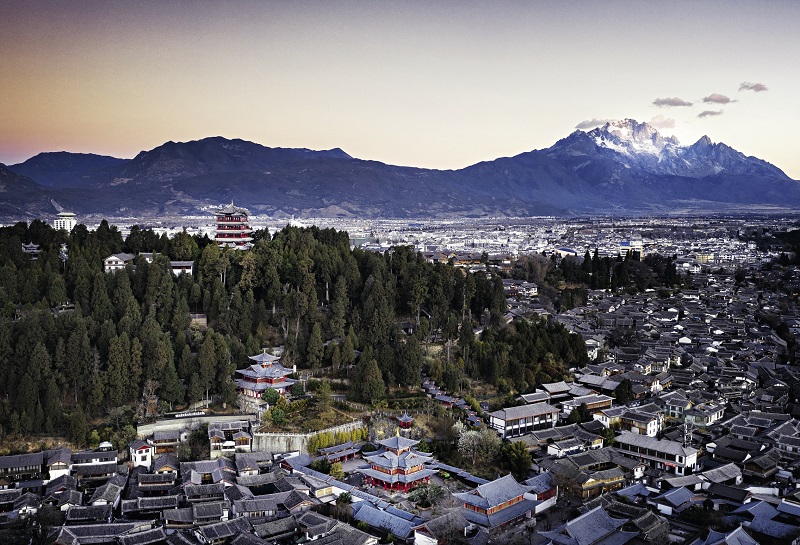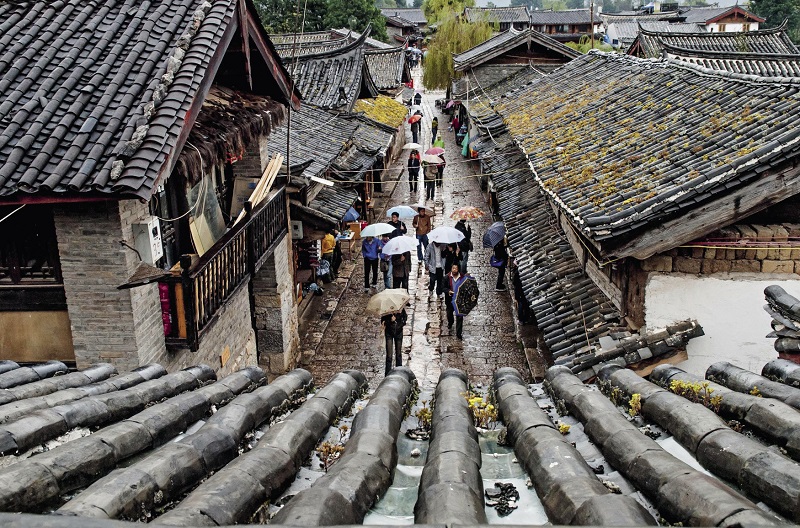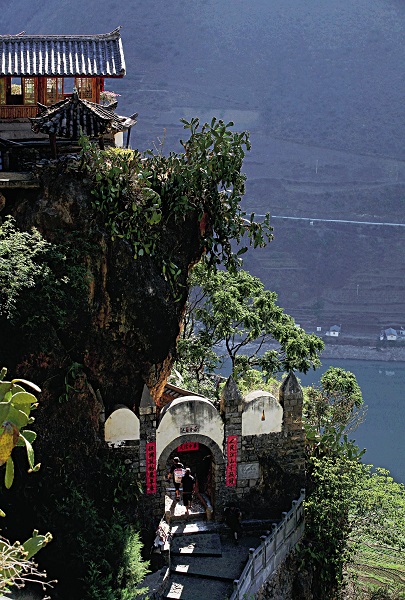The ancient city of Lijiang, in southwestern China’s Yunnan Province, is home to ancient architecture, rich ethnic culture, and a unique traditional water supply system, which have made it a world cultural heritage site. It is also home to the Chinese ethnic minority Naxi people.
An aerial view of Dayan Old Town in the city of Lijiang, Yunnan Province, with the Jade Snow Mountains in the background.

An ancient street in the old town of Shuhe on a rainy day.
Traditional Techniques of Using Natural Resources
The Lijiang basin has rich water resources, favorable weather, and vast expanses of land. The ancestors of the Naxi people decided to settle in the area and leave behind their nomadic lifestyle to take up farming.
Once settled, the Naxi built towns on the backbone of an ingenious method of transporting water into villages by creating wells that had three openings. This later became a part of the Naxi’s “one well with three openings” culture. Greater Lijiang includes the Dayan Old Town (also known as Old Town of Lijiang), Old Town of Shuhe, and the Old Town of Baisha. Wells with three openings are a very common site in Shuhe, the earliest habitation for Naxi ancestors. This unique well is actually a spring water outlet built on a three-level terrain, with the three openings serving different purposes to help conserve water resources. Water in the first opening at the high level comes directly from the spring and is therefore designated as drinking water; the water that overflows down into the second opening is clean and designated for washing vegetables, fruit, and kitchen utensils; while the water that overflows down into the third opening is designated for washing daily used items like clothing. Finally the used water are channeled into a waterway to irrigate crops. This unique well design is a prime example of the scientific, hygienic, practical, and convenient ways the Naxi people wisely use natural resources.
Today, even though modern running water facilities have been installed in every home for many years, putting an end to fetching water from the well for daily needs, the ancient tradition is so instilled in the collective memory of every local person that you will still never see young or elderly Naxi washing food in the first well opening.

An ancient street in the old town of Shuhe on a rainy day.
The Thriving Ancient Tea-Horse Trail
The Old Town of Shuhe is known as the best preserved courier station on the Ancient Tea-Horse Trail in the Lijiang basin. It is a famous cobbler village in the border region where Yunnan Province, Sichuan Province, and Tibet Autonomous Region meet. From ancient times, products made by cobblers including leather shoes, fur pelts, twine, ironware and bamboo wares could be found along the Ancient Tea-Horse Trail. Beginning in the Tang Dynasty (618-907), the variety of products along this ancient road continued to grow as demand increased. By the Ming Dynasty (1368-1644), a chieftain with the surname of Mu employed a bunch of workers from the area south of the Yangtze River who settled down in Shuhe. From that time on, these skillful craftsmen from the water towns began to flourish in the highlands of Yunnan Province. Many leather shops in Shuhe went on to leave their mark on the pages of history.
With a history of around 800 years, the Old Town of Lijiang, or Dayan, was once a prosperous trading center. Over time, the Naxi way of life developed from that of nomadic herdsman to farming, and the region changed from being a rural countryside to an urban settlement. In the evening, young Naxi women dressed up in beautiful garments can often be seen gathering around bonfires on the streets of the Old Town of Dayan performing traditional dances.
The Mufu Palace or Mu Family Mansion is located in the center of the Old Town of Dayan. Every time the Naxi mention the Lord Mu, it is always with much respect and pride. In the past, the Mufu Palace was the most powerful legal institution in the ancient city of Lijiang. It was the seat of local government in feudal China, conferred by the central government to maintain stability and peace of the border region, which it did for around 400 years. The Mufu Palace that people see today was refurbished with funding from the World Bank. The first main gate of the Mufu Palace used to be a place that everyone trading along the Ancient Tea-Horse Trail during the Ming and Qing dynasties had to pass by. The reconstructed wooden beam on the archway over the road has four Chinese characters respectively for heaven, rain, flow, and fragrance, which together are a phonetic Chinese transcription of a Naxi language phrase which means “Go and Study.” This idea demonstrates the level of importance the Naxi place on knowledge and education. In the Wanjuan Building of the Mufu Palace, there is a large collection of precious historical literature that includes the Dongba Scriptures and Tibetan Buddhist Scriptures. From the tallest building in the building complex, called Sanqing Hall, you can see the entire layout of the Old Town of Dayan and the beautiful palace.
Compared with the rather commercial atmosphere of the old towns of Dayan and Shuhe, the pace of the Old Town of Baisha is more relaxed, shops are more spread out, and there are fewer merchants calling out for people to buy their wares. The busiest places are the shops selling produce to local people. At times tourists pass by and buy meat or eggs.
The Old Town of Baisha was the first place the Naxi settled in after reaching the Lijiang basin region. It is also the birthplace of Naxi culture and the chieftain Mu. Before the Song (960-1279) and Yuan (1271-1368) dynasties, this town served as the political, economic, and cultural center of Lijiang. While wondering around the town, I suddenly heard the sound of people playing classical folk Naxi music. The music was coming from a folk band organized to help the local elderly promote Naxi culture.

The Dongba clan has preserved copies of the ancient Dongba writings and maintained the traditional culture of fortunetelling.
Dongba Culture
Most of the walls lining the streets and alleys of the Old Town of Baisha are covered with Dongba writing, a script that predates Chinese oracle bone writing. This type of writing has been recognized as the oldest complete hieroglyphic writing in the world that is still in existence. It is the “living fossil” of the beginning of human writing and development.
The name “Dongba” in Naxi language means “wise man” or “sage.” The Dongba writing originated from the classic religious and encyclopedic writings called Dongba Scriptures, and the script was mastered by sages. Content of the Dongba writings included records of songs, dances, scriptures, general literature, history, and paintings. The collection of writings has formed a cultural system that is very inclusive, profound, and mysterious, and has been completed and passed down by Dongba families for many generations.
The writings were written down on paper made from raw material of rare wild plants like the wikstroemia and processed by traditional handcraft techniques. Among the various traditional hand-crafted paper of China, only the thick Dongba paper can be written on both sides. And because the wikstroemia has the properties of microtoxic Chinese herbal medicine, this paper is resistant to insects like moths, and has a long shelf life. There is a saying among the Naxi that the paper can last for 1,000 years.
In the early 1920s, an Austrian born American named Joseph Rock came to China and conducted more than 20 years of research on the Dongba culture. He eventually published A Na-khi-English Encyclopedic Dictionary based on his extensive research, making a great contribution to the preservation of the Dongba culture. He collected around 8,000 manuscripts of classical writings and took them with him when he left China. These manuscripts were later collected in major libraries in Europe and the Americas. During Rock’s last hours of life while he lay dying in a hospital bed in Hawaii, U.S., he realized that he would not be able to return to China. As a result, he wrote a letter to his friend, in which he said that if everything goes well he would return to Lijiang to complete his unfinished work there, and then said, “I want to die among those beautiful mountains rather than in a bleak hospital bed all alone.” To the world explorer Joseph Rock, nothing could compare with the beauty of Lijiang.
A typical feature of Naxi women’s traditional clothing is a sheepskin shawl adorned with seven round embroidered cloth plates, which makes the shawl very striking. It originated from the story of “nine brothers who opened the sky and seven sisters who opened the land,” recorded in the genesis of Dongba scriptures. It is said that Naxi ancestors worshipped odd numbers of totems, which symbolized their aspirations for many children and good fortune. At the same time, these decorations also represented the Big Dipper, which locals commonly call “wearing the moon and the stars,” a symbol representing the Naxi women’s hardworking spirit of going out early in the morning and returning home late in the company of the moon and stars. Naxi women contribute much more manual labor in regular daily life and work than men. Most of the people seen working in the streets and fields are women, and they also take care of the housework when they return home. I found out that Naxi men, on the other hand, spend most of their time at home playing musical instruments and chess, reading and painting, while smoking and drinking wine and tea.

One of the entrances into Baoshan Stone Town.
The Unique Stone Town in the Mountains
Even though most Naxi live on the plains, some of the elderly still live deep in the mountains.
Baoshan Village, also called Baoshan stone town, in Yulong Naxi Autonomous County, Lijiang City, is a Naxi ethnic village. Today it is a national protected key cultural heritage site.
This stone town was built on a singular, mushroom-shaped rock, surrounded by mountains on three sides and a river on the other. The huge rock beneath the stone town is high in the west and low in the east stretching out directly to the Jinsha River. Houses here are also slightly tilted and spread out in a downward direction, and the local people’s traditional way of life has continued unchanged there for more than 900 years.
One hundred and eight families built their homes on stone, with neat houses, lanes, and stairs – half natural and half artificial – running up and down. Residential homes in this stone town are constructed to fit the geological shape of the rock. Locals slightly cut the rock to create tables and stools in the public area. Houses are built out of stones that are especially chiseled for the kitchen and oven. There is also an outdoor spring that can directly flow into the water tank on the oven, while sewage flows out of the rock home through ditches cut into the rock under the water tank. Beds are hewn out of boulders, and in the middle of beds there is a small sunken fire pit for boiling drinking water. All the daily necessities for living in the town, including heavy construction materials, are transported in manually on the backs of donkeys, horses and villagers who have a high level of fitness.
There are two main gates to the village, one in the back and one in the front, with cliffs on three sides, and a wall on the other. Traffic of people entering and leaving the village through the front gate is busiest during the early morning. Women gather green grass for their pigs in the morning and carry loads of fragrant wood on their shoulders. The back entrance of the village leads directly down to the bank of the Jinsha River, and terraced fields line both sides of the river. Distant mountains are covered in a carpet of green which gradually merges with the blue rocks. As far as the eye can see, all slopes that can be reclaimed are terraced. Hidden in the terraced fields is an irrigation system that is uniquely designed by the Naxi, combining inlets and culverts. The scientific method of watering has been used for nearly 1,000 years and is testimony to the wisdom of the Naxi. During the golden autumn season, this stone town is surrounded by ripe rice paddy fields. The wind blows the rice paddies and lines of smoke rise from cooking stoves in local homes, all creating a magical scene.
Most young people leave the village to find jobs in distant cities, leaving behind the elderly and a few dozen middle-aged people who either run local hostels or take care of the elderly. I was told people generally only return to the village from the cities for Spring Festival and a local regional festival called Pig-Butchering Festival.
There is one public elementary school in the village and all the expenses are paid for by the government. There is also a clinic equipped to treat patients suffering from minor ailments.
In the region around Baoshan stone town, many small villages are dotted about surrounded by mountain slopes covered with terraced fields. These small villages are the legacy of the ancient village settlements of Naxi in Lijiang during their nomadic period, when people endured hardships living independently in the mountains.
During early mornings in Yulong Naxi Autonomous County, the sun’s rays cover the Jade Dragon Snow Mountains like a golden carpet, filtering through the transparent clouds and highlighting the snow tops, offering a magnificent vista. The Jade Dragon Snow Mountains stand as the faithful protectors of the Naxi villages.
ZHAO YANQING is a travel columnist.